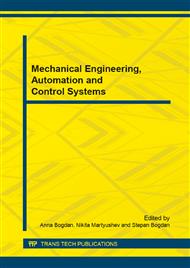p.507
p.513
p.518
p.524
p.529
p.534
p.540
p.546
p.552
The Influence of Grain Form on Effective Diffusion Coefficient of Polycrystalline
Abstract:
To study the behavior of materials with special properties, such as micro and nanograin structure, it is necessary to know how the size and the form of grain influences on the effective properties of the material. In particular, for materials with fine-dispersed structure characterized by high mass transfer rate, which could be due to several reasons. To study this kind of materials is necessary to build mathematical models taking into account the peculiarities that arise from the transition to the micro structure of the macrostructure. This paper presents a method of calculating the effective diffusion coefficient, which takes into account the influence of the size and form of grains. This method could be useful for the construction of multilayer models of mass transfer. On the example of hexagonal polycrystalline material shown that the dependence of the effective diffusion coefficient of the angle at the grain boundary acquires nonlinear character with the increase of grain boundary layer.
Info:
Periodical:
Pages:
529-533
Citation:
Online since:
April 2015
Authors:
Price:
Сopyright:
© 2015 Trans Tech Publications Ltd. All Rights Reserved
Share:
Citation:


